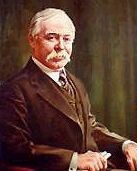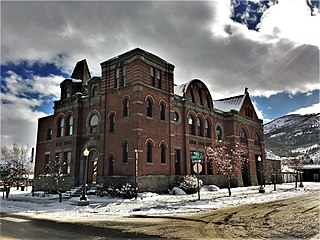
Marcus Daly was an Irish-born American businessman known as one of the three "Copper Kings" of Butte, Montana, United States.

Butte is a consolidated city-county and the county seat of Silver Bow County, Montana, United States. In 1977, the city and county governments consolidated to form the sole entity of Butte-Silver Bow. The city covers 718 square miles (1,860 km2), and, according to the 2020 census, has a population of 34,494, making it Montana's fifth largest city. It is served by Bert Mooney Airport with airport code BTM.

Anaconda, county seat of Deer Lodge County, which has a consolidated city-county government, is located in southwestern Montana, United States. Located at the foot of the Anaconda Range, the Continental Divide passes within 8 mi (13 km) south of the community. As of the 2020 census the population of the consolidated city-county was 9,421, and the US Census Bureaus's 2015-2019 American Community Survey showed a median household income of $41,820. Anaconda had earlier peaks of population in 1930 and 1980, based on the mining industry. As a consolidated city-county area, it ranks as the ninth most populous city in Montana, but as only a city is far smaller. Central Anaconda is 5,335 ft (1,626 m) above sea level, and is surrounded by the communities of Opportunity and West Valley.

Bannack is a ghost town in Beaverhead County, Montana, United States, located on Grasshopper Creek, approximately 11 miles (18 km) upstream from where Grasshopper Creek joins with the Beaverhead River south of Dillon. Founded in 1862, the town is a National Historic Landmark managed by the state of Montana as Bannack State Park.
This is a broad outline history of the state of Montana in the United States.

This is a list of properties and historic districts in Montana that are listed on the National Register of Historic Places. The state's more than 1,100 listings are distributed across all of its 56 counties.
On April 21, 1920, during a miners strike in Butte, Montana's copper mines, company guards fired on striking miners picketing near a mine of the Anaconda Copper Mining Company, killing Tom Manning and injuring sixteen others, an event known as the Anaconda Road massacre. His death went unpunished.

The Butte–Anaconda Historic District is a National Historic Landmark (NHL) that spans parts of Walkerville, Butte and Anaconda, Montana, United States. It has the most resources of any U.S. National Historic Landmark District.

The Club Moderne is a bar in Anaconda, Montana, United States, in the Streamline Moderne style. It was designed by architect Fred F. Willson and built by Frank Wullus in 1937 for John Francisco. The facade was clad in Carrara glass. The interior was similarly custom-designed and remained in a high state of preservation, with appropriate renovations in 1948. Chosen as "America's Favorite Historic Bar" in 2016 in a contest sponsored by the National Trust for Historic Preservation, beating out another notable Montana venue, the Sip 'n Dip Lounge, The building was heavily damaged by fire on the evening of October 3, 2016. The current owner, who owned the bar since 1997, expressed an intent to rebuild. Following a soft reopening on April 28, 2017, the remodeled bar reopened to the public on May 13, 2017. The owners had to replace much of the interior and refurbish the exterior, but attempted to retain its traditional look and feel. The bar and a few original furnishings were preserved along with some of the original facade.

The Mike Mansfield Federal Building and United States Courthouse is a courthouse of the United States District Court for the District of Montana, located in Butte, Montana. Completed in 1904, the building was expanded from 1932 to 1933.

The Elks Building in Anaconda, Montana was a historic building built in 1914. It is a 3-story brick building that is a contributing property in the Butte-Anaconda Historic District. It was headquarters of the Anaconda Elks until 1964, when it was transferred to the Knights of Columbus.

The Ancient Order of Hibernians Hall, also known as Hibernian Hall, was a historic building in Anaconda, Montana, United States, that is listed on the National Register of Historic Places.

The Dumas Brothel was a brothel in Butte, Montana. The brothel was founded by French-Canadian brothers Joseph and Arthur Nadeau in 1890 and named after the nominal owner, Delia Nadeau, née Dumas, who was Joseph's wife. It grew considerably through the years, with the miners employed by the city's copper mines often patronizing the establishment. After several changes of the "madams" and continuing pressure from authorities, the brothel closed in 1982, described as "a rare, intact commentary on social history". At the time of its closure, it was the longest operating brothel in the United States, having operated years after prostitution was made illegal. After closing, the brothel changed hands several times, eventually becoming a tourist attraction owned and managed by a series of Butte residents.

The Butte, Montana labor riots of 1914 were a series of violent clashes between copper miners at Butte, Montana. The opposing factions were the miners dissatisfied with the Western Federation of Miners local at Butte, on the one hand, and those loyal to the union local on the other. The dissident miners formed a new union, and demanded that all miners must join the new union, or be subject to beatings or forced expulsion from the area. Sources disagree whether the dissidents were a majority of the miners, or a militant minority. The leadership of the new union contained many who were members of the Industrial Workers of the World (I.W.W.), or agreed with the I.W.W.'s methods and objectives. The result of the dispute between rival unions was that the copper mines of Butte, which had long been a union stronghold for the WFM, became open shop employers, and recognized no union from 1914 until 1934.

Butte is a city in southwestern Montana established as a mining camp in the 1860s in the northern Rocky Mountains straddling the Continental Divide. Butte became a hotbed for silver and gold mining in its early stages, and grew exponentially upon the advent of electricity in the late-nineteenth century due to the land's large natural stores of copper. In 1888 alone, mining operations in Butte had generated an output of $23 million. The arrival of several magnates in the area around this time, later known as the "Copper Kings," marked the beginning of Butte's establishment as a boomtown.

The Anaconda Commercial Historic District is a historic district in Anaconda, Montana, United States, that is listed on the National Register of Historic Places.

The Anaconda City Hall, located at 401 E. Commercial in Anaconda, Montana, was built in 1895. It was listed on the National Register of Historic Places in 1979. It is also a contributing building in the Anaconda Commercial Historic District, NRHP-listed in 1998.

The Butte, Anaconda and Pacific Railway Historic District is a 750 acres (300 ha) historic district which was listed on the National Register of Historic Places in 1988. It covers the railway right-of-way which begins in Butte, Montana and runs to Anaconda generally along the course of Silver Bow Creek. It spans parts of Deer Lodge and Silver Bow counties. The listing included 51 contributing buildings, 34 contributing structures, and two contributing sites.
The Branscombe Automobile Machine Shop, located at 125 West Commercial in Anaconda, Montana, was built in 1916. It was listed on the National Register of Historic Places in 2000. It has also been known as Brewery Antiques & Western Montana Fur Center.

Pekin Noodle Parlor is the oldest continuously operating Chinese restaurant in the United States, located in Butte, Montana. The restaurant was founded in its current location in 1911 by Hum Yow and Tam Kwong Yee. Along with the Wah Chong Tai Company mercantile building (1891) and the Mai Wah Noodle Parlor (1909), the Pekin Noodle Parlor represents one of the last surviving properties from the original Chinatown neighborhood in the Butte–Anaconda Historic District.




















